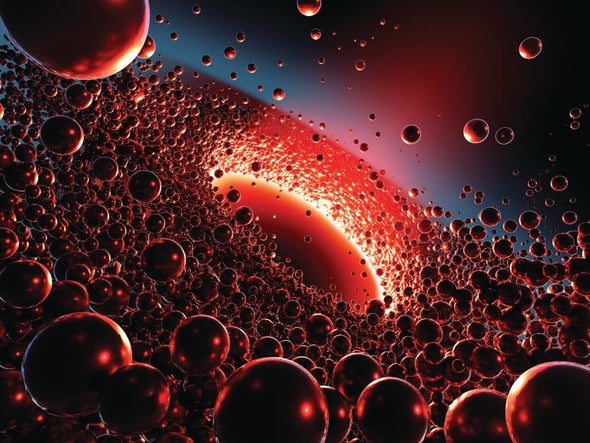Stars, planets, people and petunias: everything emits a special kind of radiation and will, if it sticks around long enough, evaporate into nothing.
That's the claim in a new study of physics effects that were previously thought to occur only near a black hole. In that extreme environment, some of the largest and smallest things in the universe rub up against one another. To describe events on such different scales, scientists must use both Einstein's theory of relativity (rules governing the big stuff) and quantum mechanics (rules for itty-bitty things), leading to some outlandish effects. But if the new calculations are correct, such evaporation may be commonplace—even when black holes aren't around.
In the 1970s the late British physicist Stephen Hawking began thinking about what happened to particles that experienced the unparalleled gravitational forces at the edge of a black hole, a place known as the event horizon. Anything slightly inside the event horizon will unavoidably fall into the black hole, whereas anything just outside it still has a chance to escape.
Hawking wanted to know what would happen to pairs of particles—a particle and its antiparticle partner—that spontaneously appeared near a black hole's event horizon. These couplets emerge from the “empty” vacuum of space, and quantum mechanics tells us they constantly wink in and out of existence everywhere. As soon as a particle meets up with its antiparticle, they destroy each other in a fraction of a second, and the universe at large doesn't notice their presence.
Hawking showed that if one of the partners appeared within the event horizon, however, it would fall into the black hole while its associate on the horizon's other side would fly outward at tremendous speed. To conserve the total energy of the black hole and abide by a tenet of physics, the infalling particle must carry negative energy (and hence negative mass), and the launched one must have positive energy. In this way, black holes emit a type of energy now called Hawking radiation, and over time this escaping positive energy depletes them, causing them to evaporate.
About six years ago astrophysicist Heino Falcke of Radboud University in the Netherlands started thinking more deeply about the physics involved in these processes—and whether the black hole's event horizon was a necessary component. In other words, could this same evaporation occur with other objects? “I asked a few experts and got very different answers,” he recalls.
Falcke enlisted the help of quantum physicist Michael Wondrak and mathematician Walter van Suijlekom, both at Radboud, to take another look at the issue. The trio decided to approach the topic from an atypical angle. The scientists used equations from a related phenomenon known as the Schwinger effect, which describes how charged particles and antiparticles get torn apart when they emerge from the vacuum in the presence of a powerful electromagnetic field. The process could be considered analogous to particle pairs experiencing strong gravitational forces at a black hole's event horizon.
The researchers' mathematical analysis showed how any object with mass—and not just a superheavy one such as a black hole—affects the pairs of particles and antiparticles that emerge from the vacuum of space. In more wavelike terms, these particles can be thought of as having a cloud of probability regarding where they might be located in space, says Tyler McMaken, a Ph.D. student who studies theoretical astrophysics at the University of Colorado Boulder. In the absence of any external forces, electromagnetic or gravitational, the clouds of both the particle and the antiparticle will overlap, and they will annihilate each other. But if gravity or some other force tugs on one cloud more than the other, each will be shifted slightly. They won't overlap and therefore won't be annihilated. Instead they will produce radiation, much like a particle that gets flung from a black hole's event horizon.
The team's calculations, published recently in Physical Review Letters, suggest that anything with gravity (meaning basically every object in the universe) will emit a Hawking-like radiation and eventually evaporate. The equations indicate that this process will take trillions on trillions of years, so it's likely that you and your personal belongings will be long gone before this effect comes into play. But the long-lived remnants of dead stars such as white dwarfs and neutron stars—which have enormous mass—might have their lives shortened if the phenomenon is real.
The analysis seems promising, says McMaken, who was not involved in the work. “This shows that there is definitively some effect where particles can be ripped apart just solely from gravitational forces in the vacuum,” he adds. McMaken and his colleagues have considered doing similar calculations, he says, so he's pleased that scientists did a thorough check to see what happens in these situations.
But other researchers disagree. “Personally, I'd be kind of skeptical that all previous calculations are wrong” about what happens to particles near massive objects, says theoretical physicist Sabine Hossenfelder of the Munich Center for Mathematical Philosophy. She suspects that a more careful analysis would show that the particle-antiparticle pairs don't actually radiate from massive objects other than black holes.
Current technology isn't sensitive enough to detect this evaporative effect and prove the new claim one way or another. Falcke and his team suggest that further experiments could focus on observing the Schwinger effect, which also remains theoretical at this point, to potentially bolster their claims.


